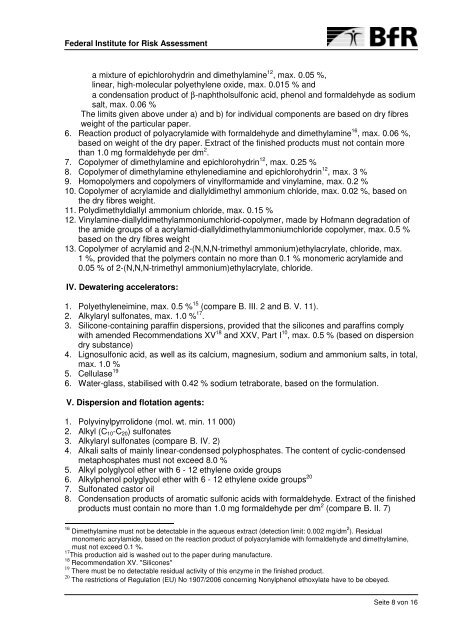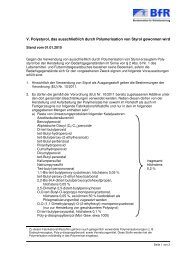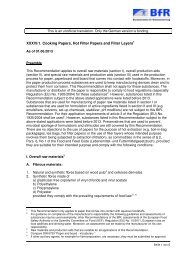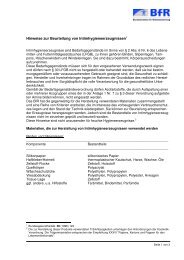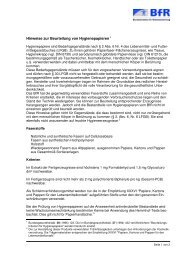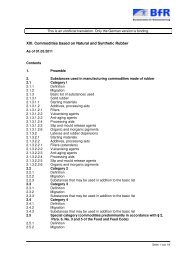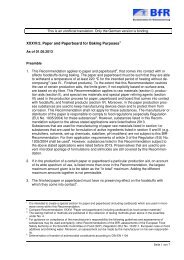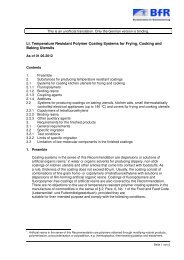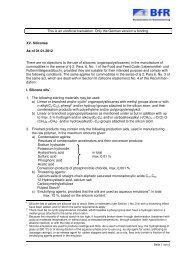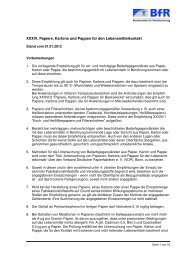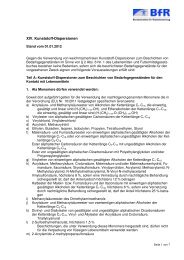XXXVI. Paper and board for food contact
XXXVI. Paper and board for food contact
XXXVI. Paper and board for food contact
You also want an ePaper? Increase the reach of your titles
YUMPU automatically turns print PDFs into web optimized ePapers that Google loves.
Federal Institute <strong>for</strong> Risk Assessment<br />
a mixture of epichlorohydrin <strong>and</strong> dimethylamine 12 , max. 0.05 %,<br />
linear, high-molecular polyethylene oxide, max. 0.015 % <strong>and</strong><br />
a condensation product of β-naphtholsulfonic acid, phenol <strong>and</strong> <strong>for</strong>maldehyde as sodium<br />
salt, max. 0.06 %<br />
The limits given above under a) <strong>and</strong> b) <strong>for</strong> individual components are based on dry fibres<br />
weight of the particular paper.<br />
6. Reaction product of polyacrylamide with <strong>for</strong>maldehyde <strong>and</strong> dimethylamine 16 , max. 0.06 %,<br />
based on weight of the dry paper. Extract of the finished products must not contain more<br />
than 1.0 mg <strong>for</strong>maldehyde per dm 2 .<br />
7. Copolymer of dimethylamine <strong>and</strong> epichlorohydrin 12 , max. 0.25 %<br />
8. Copolymer of dimethylamine ethylenediamine <strong>and</strong> epichlorohydrin 12 , max. 3 %<br />
9. Homopolymers <strong>and</strong> copolymers of vinyl<strong>for</strong>mamide <strong>and</strong> vinylamine, max. 0.2 %<br />
10. Copolymer of acrylamide <strong>and</strong> diallyldimethyl ammonium chloride, max. 0.02 %, based on<br />
the dry fibres weight.<br />
11. Polydimethyldiallyl ammonium chloride, max. 0.15 %<br />
12. Vinylamine-diallyldimethylammoniumchlorid-copolymer, made by Hofmann degradation of<br />
the amide groups of a acrylamid-diallyldimethylammoniumchloride copolymer, max. 0.5 %<br />
based on the dry fibres weight<br />
13. Copolymer of acrylamid <strong>and</strong> 2-(N,N,N-trimethyl ammonium)ethylacrylate, chloride, max.<br />
1 %, provided that the polymers contain no more than 0.1 % monomeric acrylamide <strong>and</strong><br />
0.05 % of 2-(N,N,N-trimethyl ammonium)ethylacrylate, chloride.<br />
IV. Dewatering accelerators:<br />
1. Polyethyleneimine, max. 0.5 % 15 (compare B. III. 2 <strong>and</strong> B. V. 11).<br />
2. Alkylaryl sulfonates, max. 1.0 % 17 .<br />
3. Silicone-containing paraffin dispersions, provided that the silicones <strong>and</strong> paraffins comply<br />
with amended Recommendations XV 18 <strong>and</strong> XXV, Part I 10 , max. 0.5 % (based on dispersion<br />
dry substance)<br />
4. Lignosulfonic acid, as well as its calcium, magnesium, sodium <strong>and</strong> ammonium salts, in total,<br />
max. 1.0 %<br />
5. Cellulase 19<br />
6. Water-glass, stabilised with 0.42 % sodium tetraborate, based on the <strong>for</strong>mulation.<br />
V. Dispersion <strong>and</strong> flotation agents:<br />
1. Polyvinylpyrrolidone (mol. wt. min. 11 000)<br />
2. Alkyl (C10-C20) sulfonates<br />
3. Alkylaryl sulfonates (compare B. IV. 2)<br />
4. Alkali salts of mainly linear-condensed polyphosphates. The content of cyclic-condensed<br />
metaphosphates must not exceed 8.0 %<br />
5. Alkyl polyglycol ether with 6 - 12 ethylene oxide groups<br />
6. Alkylphenol polyglycol ether with 6 - 12 ethylene oxide groups 20<br />
7. Sulfonated castor oil<br />
8. Condensation products of aromatic sulfonic acids with <strong>for</strong>maldehyde. Extract of the finished<br />
products must contain no more than 1.0 mg <strong>for</strong>maldehyde per dm 2 (compare B. II. 7)<br />
16 Dimethylamine must not be detectable in the aqueous extract (detection limit: 0.002 mg/dm 2 ). Residual<br />
monomeric acrylamide, based on the reaction product of polyacrylamide with <strong>for</strong>maldehyde <strong>and</strong> dimethylamine,<br />
must not exceed 0.1 %.<br />
17 This production aid is washed out to the paper during manufacture.<br />
18 Recommendation XV. "Silicones"<br />
19 There must be no detectable residual activity of this enzyme in the finished product.<br />
20 The restrictions of Regulation (EU) No 1907/2006 concerning Nonylphenol ethoxylate have to be obeyed.<br />
Seite 8 von 16


